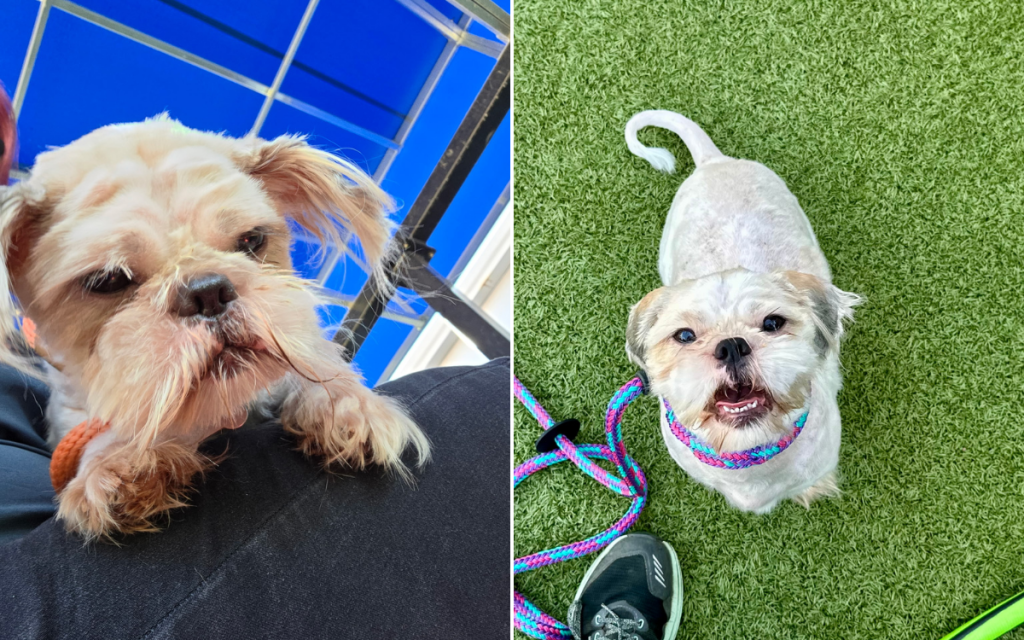A Dog’s Journey Home: The Miraculous Reunion of Chase and His Owner
Chase arrived at the Saint Louis County Pet Adoption Center in Olivette, Missouri in a heartbreaking condition. When Animal Control Officers responded to a call about an injured stray roaming the county, they found a dog in desperate need of care. Though Chase wasn’t injured as initially reported, his appearance told the story of a difficult life on the streets. His fur was severely matted, his nails had grown so long that walking was uncomfortable, and his body was covered in fleas. The shelter staff could only imagine what this poor dog had endured during his time as a stray. Thankfully, a compassionate shelter volunteer named Nikki Miller stepped in to help, bathing Chase, trimming his overgrown nails, and shaving his matted fur to restore some dignity to this forgotten pet.
Like millions of other dogs in America, Chase faced an uncertain future in the shelter system. According to Shelter Animals Count, approximately 2.9 million dogs entered U.S. shelters in 2024 alone. Only about 554,000 of these dogs were reunited with their owners—a number that represents a 3.3 percent decline from the previous year. For most stray dogs, finding their way back to their original families is uncommon and often seems impossible. Dogs like Chase typically face extended stays in shelters, with outcomes ranging from adoption by new families to less fortunate ends. The overcrowding in shelters across the country makes each case like Chase’s particularly poignant, as shelter workers try to provide care while dealing with limited resources and space.
What made Chase’s case different was a tiny device—a microchip implanted under his skin. When shelter staff scanned Chase, they discovered something unexpected: this disheveled stray had once been a beloved pet with a home and a human who missed him dearly. The microchip revealed that Chase belonged to a woman named Kimwanna, who had lost him months earlier on March 21. Mitchell Finnegan, public information manager for the shelter, explained that Chase had simply been let out in his yard to use the bathroom, but when Kimwanna returned, he had vanished. Security footage later revealed that a stranger had taken Chase from the yard. After searching extensively for her missing companion, Kimwanna eventually had to give up hope as she prepared for a scheduled move to Chicago, hundreds of miles away.
The period between Chase’s disappearance and his arrival at the shelter remains a mystery. Based on his condition, shelter staff believe he spent significant time as a stray rather than in someone’s care. “If he was in someone’s care, they neglected caring for him,” Finnegan noted. One can only imagine what Chase experienced during those months—the confusion, fear, and likely desperate attempts to find his way back to the home and person he loved. For dogs, who form deep attachments to their humans, such separation can be traumatic. Chase may have spent days, weeks, or months trying to navigate back to Kimwanna, relying on instincts and facing the dangers of life on the streets, from traffic and harsh weather to the challenge of finding food and shelter.
The reunion between Chase and Kimwanna would have been impossible without that small microchip. “If Chase did not have a microchip, he probably would have never been reunited with Kimwanna,” Finnegan explained. “With Kimwanna and Chase having so much distance between them, it would be nearly impossible to reunite them without Chase having a microchip.” This technology—smaller than a grain of rice and relatively inexpensive to implant—made the difference between Chase spending his life in the shelter system and returning to the arms of someone who loved him. When the shelter contacted Kimwanna with the news that Chase had been found, it must have seemed like a miracle. Despite having moved to Chicago and likely adjusted to life without her beloved pet, she now had the chance to welcome Chase back into her life.
Chase’s story serves as a powerful reminder of the importance of microchipping pets. In a system where millions of animals enter shelters each year and only a fraction find their way back to their original homes, this simple technology can be the difference between permanent separation and joyful reunion. “It is the best way of reuniting an animal with their owner, and it keeps owned pets out of the shelter, saving space for animals who have nowhere to go,” Finnegan emphasized. “No one wants to lose a pet, but it happens. Microchipping your pets is the best way to make sure you can be reunited, should they ever go missing!” Chase’s journey from beloved pet to stray and back to his owner illustrates both the heartbreak of pet loss and the hope that technology offers for happy endings. For every Chase who finds his way home, there are countless others still waiting, their stories yet unwritten, their futures dependent on the kindness of strangers and the responsible choices of pet owners everywhere.














